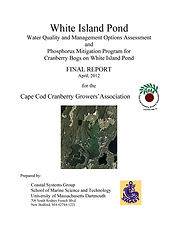SPC PUBLICATIONS
SPC, under FoEM's "Savery Pond Project", performed a hydrologic evaluation of Savery Pond that addresses precipitation, groundwater and surface-water elements of the pond hydrology. The study tracks water levels, maps groundwater flow directions, measures pond outflows to Herring Brook, discusses interactions between the pond and the regional aquifer, estimates pond residence times and considers subsurface transport of septic effluent.
SPC performed hydrogeologic reconnaissance of the East Bog. We characterized a shallow, perched groundwater system beneath the bog, its relationship to bog ditches and Savery Pond, and water quality in bog ditches and groundwater.
SPC, under FoEM's "Savery Pond Project", compiled and interpreted all known data collected on Savery Pond through summer of 2016. Summer 2017 data have not yet been interpreted or added to the summary. A brief, 2-page summary of this comprehensive report can be found here.
SPC, under FoEM's "Savery Pond Project, performed a bathymetric survey of Savery Pond to map the pond depth and estimate the pond volume.
SPC, under FoEM's "Savery Pond Project", commissioned a preliminary study of water quality and sediment quality in Savery Pond in 2012. This early study identified elevated nutrient concentrations.
A plant survey of Savery Pond was performed by Irina Kadis (Botanist at the Arnold Arboretum) in June 2012. The survey was updated in the summer of 2017 and published online by the author here.
OTHER PUBLICATIONS
TMDL Solutions (Water Scientist Ed Eichner) analyzed the data collected from intensive 2016 monitoring by the Town of Plymouth and FoEM. The data showed periodic variation between thermal stratification and mixing, along with formation of anoxic conditions near the pond bottom that tends to support increased rates of nutrient regeneration from the sediments, thus feeding the algal population.
The Town of Plymouth's Department of Marine & Environmental Affairs oversaw sampling of 39 Plymouth Ponds, and the data were interpreted by UMass Dartmouth's School for Marine Science and Technology (SMAST) and published in the Plymouth "Pond and Lake Atlas". Out of the 39 sampled ponds, Savery Pond was the most impaired with respect to nutrient concentrations.
In the early 1970's, Lyons-Skwarto Associates performed a baseline survey and modified eutrophication index analysis of 41 ponds in Plymouth MA. Volume V includes Savery Pond and 8 other ponds.
The U.S. Geological Survey (2009) characterized the hydrogeology of the Plymouth-Carver-Kingston-Duxbery aquifer system and developed a computer model to simulate flow through the groundwater flow system.
The U.S. Geological Survey (1992) characterized the hydrogeology of the Plymouth-Carver aquifer and developed a computer model to simulate flow through the groundwater flow system.
The UMass Dartmouth's School for Marine Science and Technology (SMAST) developed a Water Quality & Management Options Assessment and Phosphorus Mitigation Program for White Island Pond in Plymouth MA. The mitigation was reportedly successful and algal blooms have declined significantly.













